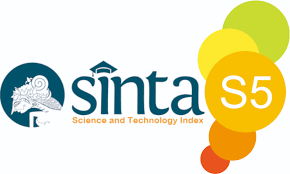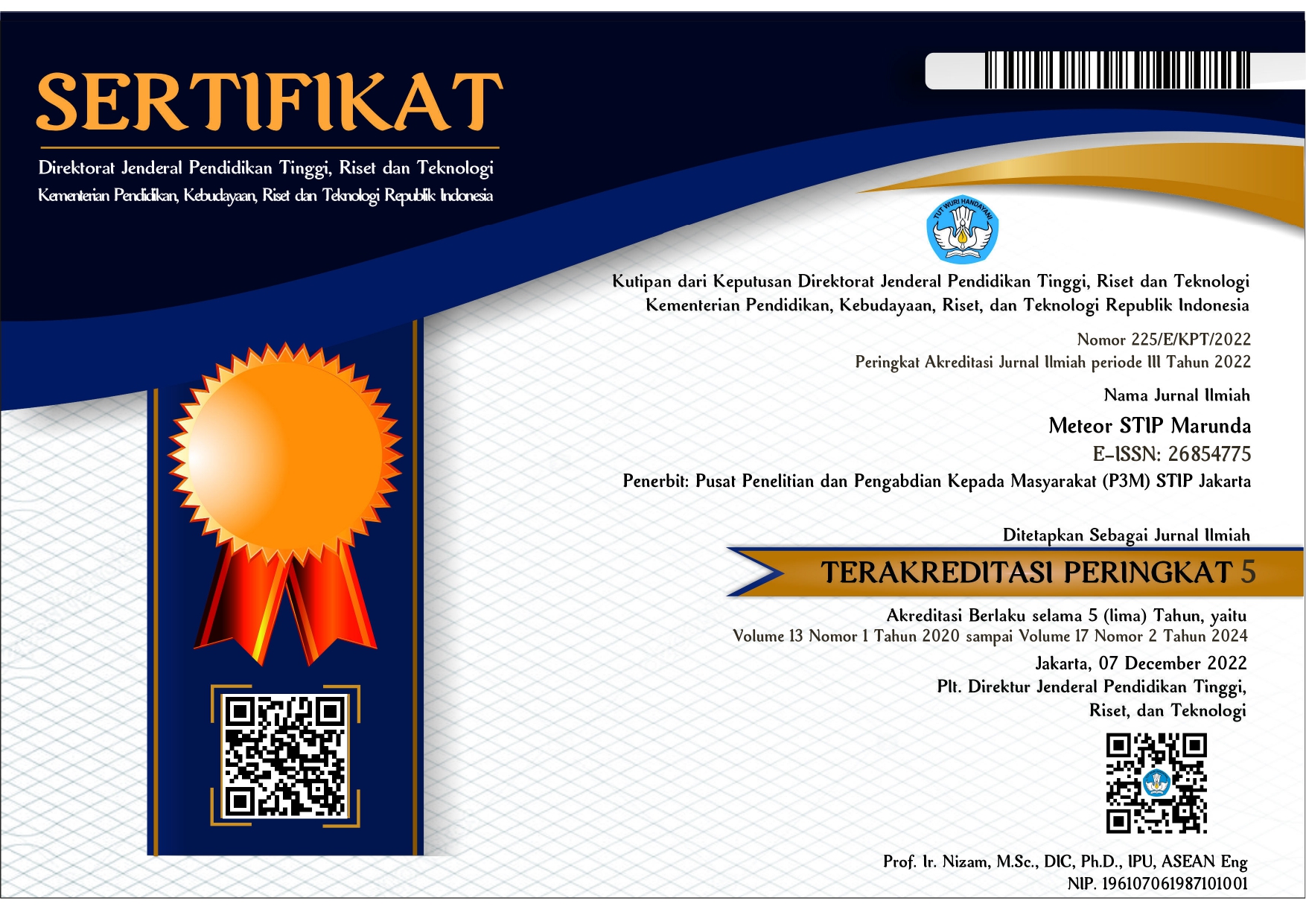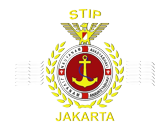Submission Preparation Checklist
As part of the submission process, authors are required to check off their submission's compliance with all of the following items, and submissions may be returned to authors that do not adhere to these guidelines.- The article to be submitted has not been published before and is not in the process of being submitted in another journal.
- Make sure the contents of the article do not contain elements of plagiarism.
- Make sure you have read and followed the writing instructions listed on the website. Please download the journal template to help adjust the standard Meteor STIP Marunda journal article format.
Author Guidelines
General Instructions
Article manuscripts are written on A4 paper (21 cm x 29.7 cm) with a minimum of 5 pages. Writing articles using Times New Roman font, size 11 pts, with a top margin, bottom margin, left margin and right margin measuring 20 mm. Article manuscripts are made using Microsoft Word with single space spacing. Article manuscripts are written in Indonesian. For article layout, please follow the template.
Writing Instructions
Abstract
Abstract is written in Indonesian and English, Times New Roman Italic 10 points, typed in single space. The contents of the abstract must include the background of the problem, the purpose & benefits of the research, the method / method of solving, the discussion and the results obtained and the conclusion.
1. INTRODUCTION
The introduction must cover several things, namely: 1) background to the problem. The importance of research to be carried out must be pointed out. 2) Review of previous studies. Describe the previous studies related to the current research, then state the position and differences between the current research and previous research. 3) The purpose and benefits of the research. There are no sub chapters in the introduction.
2. METODE
At a minimum, the contents of the method must include several things, namely: 1) Research object. Describe the object of research. Describe the acquisition of research data. 2) Treatment of the research object. State the fixed and variable variables from the research, what variations were carried out in the research. 3) The method / way of solving along with the procedures used to research. State whether the method has been widely used or the newest method along with the advantages and disadvantages of the method. 4) Tools and materials used in the research. Describe the main tools and materials used. No need to explain in detail.
3. RESULTS AND DISCUSSION
The contents of the Results and Discussion are the results of the research and its discussion. In this chapter it is not permissible to only display research data without discussion. The contents of the discussion can also be compared with research data from other researchers. State whether the research results are in line with the existing theory or with other similar studies. The impact of changing the variables that have been stated in the Methods Chapter must also be explained along with the scientific reasons.
Table
Writing tables starts from 1 to finish and is not associated with chapters or sub-chapters. For example Table 1. And not Table 3.1. The name of the table title is written in capital letters at the beginning of the word. The table position along with the table center title, and is above the table.
Tables are made with horizontal lines without vertical lines. The table is created without color. Table labels use bold (Bold). If the table is wide enough, then the table can be used as 1 column. The table must be "in line with text", it cannot be above the text. So that if there is editing of the article, such as pressing enter, the table changes too. To refer to a table, do not use the word "above", (eg: "in the table above"), but directly refer to the name of the table, (eg: "in Table 1"). An example of a table can be seen in the template.
Pictures and Graphics
Images and graphics must be displayed clearly and not blurry. The position must be in the "center" and "in line with text". Image numbering starts from 1 to completion and is not associated with chapters or sub-chapters. The image title is right below the image. The name of the title of the image is written in capital letters at the beginning of the word. To refer to an image, do not use the word "above", (eg "in the image above"), but directly refer to the name of the image, (eg: "in Figure 1"). An example of an image can be seen in the template.
Mathematical Equations
Equations are written using the equation editor on Mic. word. Mathematical equations are written in a table with 2 columns without a border. The first column is for writing mathematical equations. The position of the equation is in the middle of the column (center). The second column is for writing the equation number. The equation number starts from 1 to finish without being associated with a chapter or sub-chapter. Equation numbers are in brackets, for example: (1) and are aligned right (Align Right). The explanation of the equation symbol is explained in the paragraph, not allowed to go down. Examples of writing mathematical equations along with symbol explanations can be seen in the template.
4. CONCLUSION
The conclusion must answer the purpose of the research. Avoid bullets and numbering in conclusions. If it is really needed, the numbering must be done horizontally as follows: 1) Fill in number one. 2) Fill in number two. 3) Fill in number three. There are no sub-chapters in the conclusion.
THANK-YOU NOTE
If necessary, please express thanks to the person/institution that assisted with the research.
BIBLIOGRAPHY
All references referred to in the article must be listed in the bibliography with a minimum number of 10 references / citations in each article. Bibliography must contain references from primary sources (scientific journals) published no later than the last 5 (five) years. Writing a reference system in the text of an article and writing a bibliography should use reference management application programs such as Mendeley, EndNote and Zotero. with the format IEEE (numbering).
It is not recommended to write manually. The bibliography is written in Times New Roman 11. Examples of writing references (citations) and bibliography are as follows.
For books [1], book chapters [2], online journal / e-journal articles [3-4], conference articles [5].
[1] O. M. Faltinsen, Hydrodynamics of High-Speed Marine Vehicle, Cambridge: Cambridge University Press, 2005.
[2] W. S. Vorus, "Vibration," in Principle of Naval Architecture Series, Jersey City, The Society of Naval Architects and Marine Engineers, 2010
[3] H. Hashimoto, S. Yoneda, Y. Tahara and E. Kobayashi, "CFD-Based Study on the Prediction of Wave-Induced Surge Force," Ocean Engineering, vol. 120, p. 389-397, 2016.
[4] M. Iqbal and G. Rindo, "The Effect of Anti-Slamming Bulbous Bow on Slamming Movement on Pioneer 200 DWT Ships," SHIP, vol. 13, no. 1, pp. 45-54, 2016. [Online]. DOI: 10.12777/kpl.13.1.45-54 [Accessed 9 February 2017].
[5] M. Iqbal and I. K. A. P. Utama, "An Investigation into the Effect of Water Depth on the Resistance Components of Trimaran Configuration," in The 9th International Conference on Marine Technology, Surabaya, 2014.
Submission Preparation Checklist
As part of the submission process, authors are required to check off their submission's compliance with all of the following items, and submissions may be returned to authors that do not adhere to these guidelines.
-
The article to be submitted has not been published before and is not in the process of being submitted in another journal.
- Make sure the contents of the article do not contain elements of plagiarism.
-
Make sure you have read and followed the writing instructions listed on the website. Please download the journal template to help adjust the standard Meteor STIP Marunda journal article format.
Copyright Notice
Perjanjian Pengalihan Hak Cipta (Copyright)
Copyright includes the exclusive right to produce and provide the article in all forms and media, including reprints, photographs, microfilm and any other similar reproductions, and translations. The author still has the right to the following:
- Duplicate all or part of published material for use by the author himself as teaching material in class or oral presentation material in various forums;
- Reuse part or all of the material as compilation material for subsequent author's writings;
- Make copies of published material for distribution in the environment institution where the author works.
Dr. APRIL GUNAWAN MALAU, MM
Editor Jurnal Meteor STIP Marunda, Pusat Penelitian dan Pengabdian kepada Masyarakat (P3M)
Sekolah Tinggi Ilmu Pelayaran (STIP) Jakarta
Jln. Marunda Makmur, Cilincing, Jakarta Utara
E-mail: [email protected]
Privacy Statement
The names and email addresses entered in this journal site will be used exclusively for the stated purposes of this journal and will not be made available for any other purpose or to any other party.








